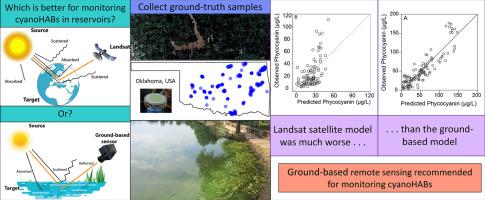Water Research ( IF 11.4 ) Pub Date : 2023-05-23 , DOI: 10.1016/j.watres.2023.120076 Katherine V Cook 1 , Jessica E Beyer 1 , Xiangming Xiao 2 , K David Hambright 3

|
Cyanobacteria are the most prevalent bloom-forming harmful algae in freshwater systems around the world. Adequate sampling of affected systems is limited spatially, temporally, and fiscally. Remote sensing using space- or ground-based systems in large water bodies at spatial and temporal scales that are cost-prohibitive to standard water quality monitoring has proven to be useful in detecting and quantifying cyanobacterial harmful algal blooms. This study aimed to identify a regional `universal' multispectral reflectance model that could be used for rapid, remote detection and quantification of cyanoHABs in small- to medium-sized productive reservoirs, such as those typical of Oklahoma, USA. We aimed to include these small waterbodies in our study as they are typically overlooked in larger, continental wide studies, yet are widely distributed and used for recreation and drinking water supply. We used Landsat satellite reflectance and in-situ pigment data spanning 16 years from 38 reservoirs in Oklahoma to construct empirical linear models for predicting concentrations of chlorophyll-a and phycocyanin, two key algal pigments commonly used for assessing total and cyanobacterial algal abundances, respectively. We also used ground-based hyperspectral reflectance and in-situ pigment data from seven reservoirs across five years in Oklahoma to build multispectral models predicting algal pigments from newly defined reflectance bands. Our Oklahoma-derived Landsat- and ground-based models outperformed established reflectance-pigment models on Oklahoma reservoirs. Importantly, our results demonstrate that ground-based multispectral models were far superior to Landsat-based models and the Cyanobacteria Index (CI) for detecting cyanoHABs in highly productive, small- to mid-sized reservoirs in Oklahoma, providing a valuable tool for water management and public health. While satellite-based remote sensing approaches have proven effective for relatively large systems, our novel results indicate that ground-based remote sensing may offer better cyanoHAB monitoring for small or highly dendritic turbid lakes, such as those throughout the southern Great Plains, and thus prove beneficial to efforts aimed at minimizing public health risks associated with cyanoHABs in supply and recreational waters.
中文翻译:

地面遥感为小湖泊蓝藻监测提供了卫星替代方案
蓝藻是世界各地淡水系统中最常见的水华形成有害藻类。对受影响系统的充分采样在空间、时间和财政上都受到限制。在大型水体中使用基于空间或地面的系统进行遥感在空间和时间尺度上进行标准水质监测的成本高昂,已被证明可用于检测和量化蓝藻有害藻华。本研究旨在确定一个区域“通用”多光谱反射率模型,该模型可用于快速、远程检测和量化中小型生产性水库(例如美国俄克拉荷马州的典型水库)中的氰基HAB。我们的目标是将这些小型水体纳入我们的研究中,因为它们通常在较大的、整个大陆的研究中被忽视,但它们却广泛分布并用于娱乐和饮用水供应。我们使用来自俄克拉荷马州 38 个水库的Landsat 卫星反射率和原位a和藻蓝蛋白的浓度,这两种关键藻色素分别常用于评估总藻丰度和蓝藻丰度。我们还使用俄克拉荷马州五年内七个水库的地面高光谱反射率和原位色素数据来构建多光谱模型,根据新定义的反射率波段预测藻类色素。我们源自俄克拉荷马州的陆地卫星和地面模型优于俄克拉荷马州水库已建立的反射色素模型。重要的是,我们的结果表明,在俄克拉荷马州高产中小型水库中检测蓝藻HAB方面,地面多光谱模型远远优于基于陆地卫星的模型和蓝藻指数(CI),为水管理提供了宝贵的工具和公共卫生。虽然基于卫星的遥感方法已被证明对相对较大的系统有效,但我们的新颖结果表明,地面遥感可以为小型或高度树枝状浑浊湖泊(例如整个大平原南部的湖泊)提供更好的cyanoHAB监测,从而证明有利于旨在最大限度地减少供水和娱乐用水中与氰基有害细菌相关的公共健康风险的努力。









































 京公网安备 11010802027423号
京公网安备 11010802027423号